Evaluating Australia's Healthcare Pricing System and its Impact
VerifiedAdded on 2022/10/01
|5
|1376
|25
Report
AI Summary
This report analyzes the pricing system in Australia's public hospitals, focusing on Activity Based Funding (ABF) and the National Efficient Price (NEP). ABF incentivizes hospitals to reduce patient stay lengths and operational costs without compromising care quality, leading to a decrease in mortality rates. The NEP aims to improve health outcomes, particularly in rural areas, by providing a consistent approach to funding and incentivizing productivity improvements through technology adoption. Both models contribute to the value of public investment in hospital care and support healthcare access for disadvantaged populations, though challenges remain in ensuring equitable application across diverse jurisdictions and maintaining a patient-centered approach amidst efficiency drives. Desklib provides access to similar solved assignments and study tools for students.
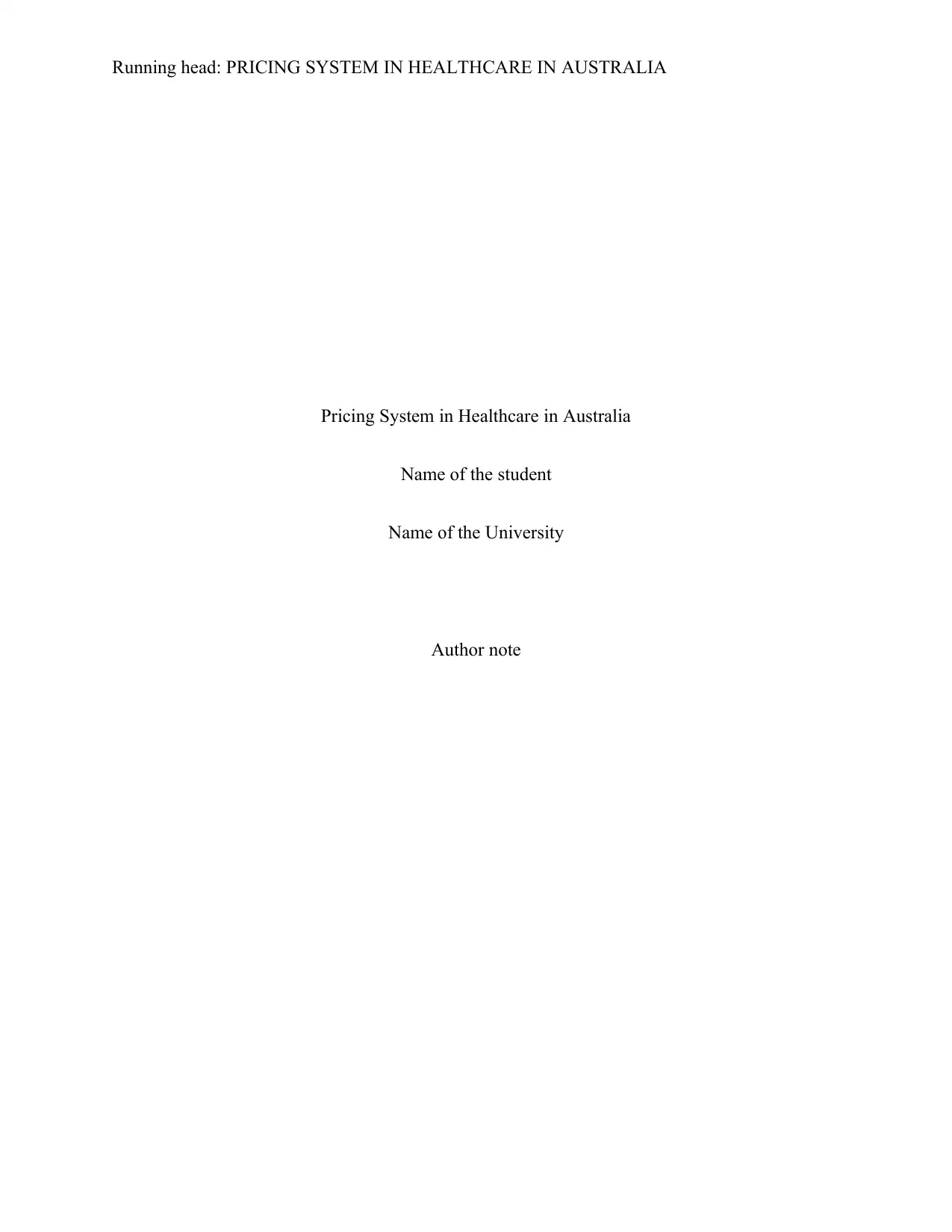
Running head: PRICING SYSTEM IN HEALTHCARE IN AUSTRALIA
Pricing System in Healthcare in Australia
Name of the student
Name of the University
Author note
Pricing System in Healthcare in Australia
Name of the student
Name of the University
Author note
Paraphrase This Document
Need a fresh take? Get an instant paraphrase of this document with our AI Paraphraser
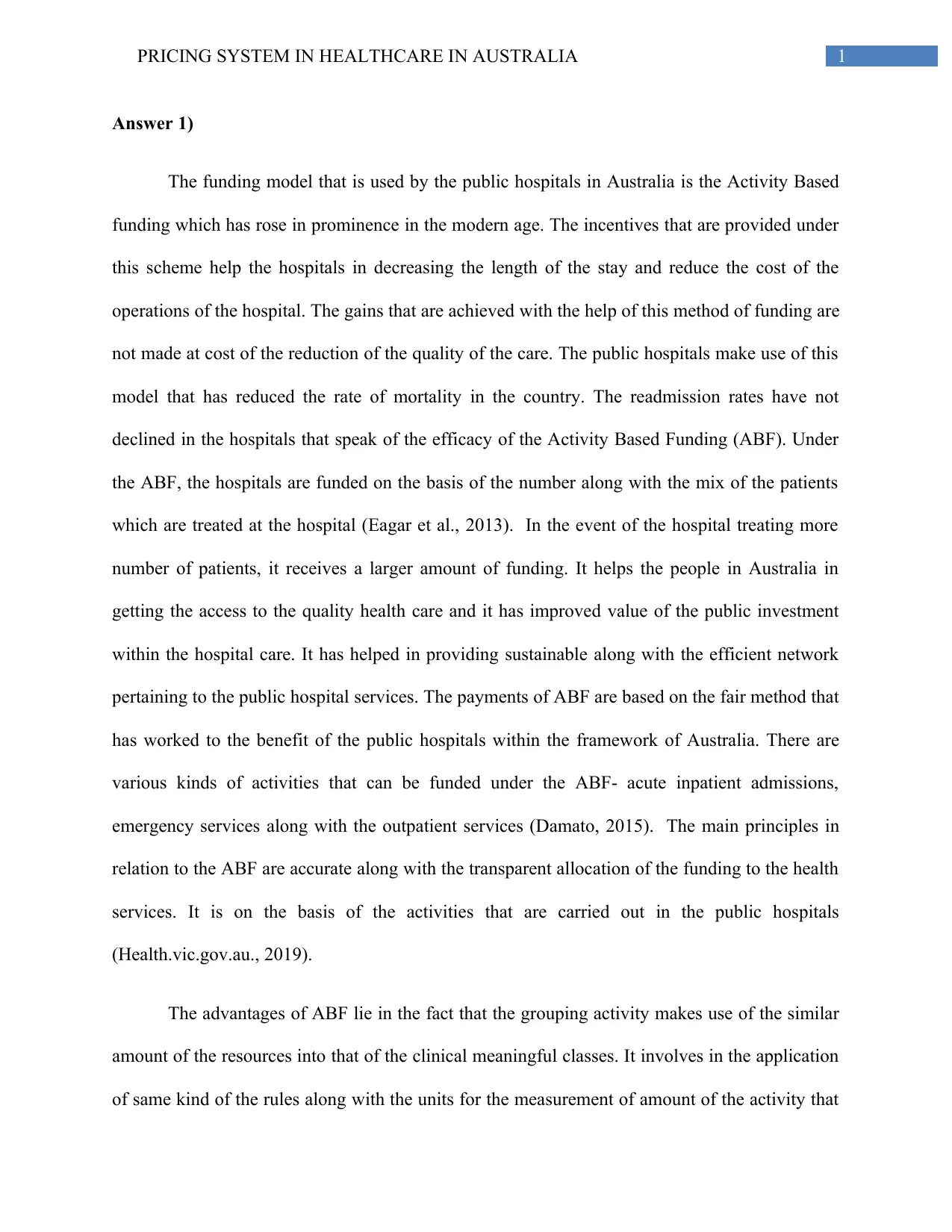
1PRICING SYSTEM IN HEALTHCARE IN AUSTRALIA
Answer 1)
The funding model that is used by the public hospitals in Australia is the Activity Based
funding which has rose in prominence in the modern age. The incentives that are provided under
this scheme help the hospitals in decreasing the length of the stay and reduce the cost of the
operations of the hospital. The gains that are achieved with the help of this method of funding are
not made at cost of the reduction of the quality of the care. The public hospitals make use of this
model that has reduced the rate of mortality in the country. The readmission rates have not
declined in the hospitals that speak of the efficacy of the Activity Based Funding (ABF). Under
the ABF, the hospitals are funded on the basis of the number along with the mix of the patients
which are treated at the hospital (Eagar et al., 2013). In the event of the hospital treating more
number of patients, it receives a larger amount of funding. It helps the people in Australia in
getting the access to the quality health care and it has improved value of the public investment
within the hospital care. It has helped in providing sustainable along with the efficient network
pertaining to the public hospital services. The payments of ABF are based on the fair method that
has worked to the benefit of the public hospitals within the framework of Australia. There are
various kinds of activities that can be funded under the ABF- acute inpatient admissions,
emergency services along with the outpatient services (Damato, 2015). The main principles in
relation to the ABF are accurate along with the transparent allocation of the funding to the health
services. It is on the basis of the activities that are carried out in the public hospitals
(Health.vic.gov.au., 2019).
The advantages of ABF lie in the fact that the grouping activity makes use of the similar
amount of the resources into that of the clinical meaningful classes. It involves in the application
of same kind of the rules along with the units for the measurement of amount of the activity that
Answer 1)
The funding model that is used by the public hospitals in Australia is the Activity Based
funding which has rose in prominence in the modern age. The incentives that are provided under
this scheme help the hospitals in decreasing the length of the stay and reduce the cost of the
operations of the hospital. The gains that are achieved with the help of this method of funding are
not made at cost of the reduction of the quality of the care. The public hospitals make use of this
model that has reduced the rate of mortality in the country. The readmission rates have not
declined in the hospitals that speak of the efficacy of the Activity Based Funding (ABF). Under
the ABF, the hospitals are funded on the basis of the number along with the mix of the patients
which are treated at the hospital (Eagar et al., 2013). In the event of the hospital treating more
number of patients, it receives a larger amount of funding. It helps the people in Australia in
getting the access to the quality health care and it has improved value of the public investment
within the hospital care. It has helped in providing sustainable along with the efficient network
pertaining to the public hospital services. The payments of ABF are based on the fair method that
has worked to the benefit of the public hospitals within the framework of Australia. There are
various kinds of activities that can be funded under the ABF- acute inpatient admissions,
emergency services along with the outpatient services (Damato, 2015). The main principles in
relation to the ABF are accurate along with the transparent allocation of the funding to the health
services. It is on the basis of the activities that are carried out in the public hospitals
(Health.vic.gov.au., 2019).
The advantages of ABF lie in the fact that the grouping activity makes use of the similar
amount of the resources into that of the clinical meaningful classes. It involves in the application
of same kind of the rules along with the units for the measurement of amount of the activity that
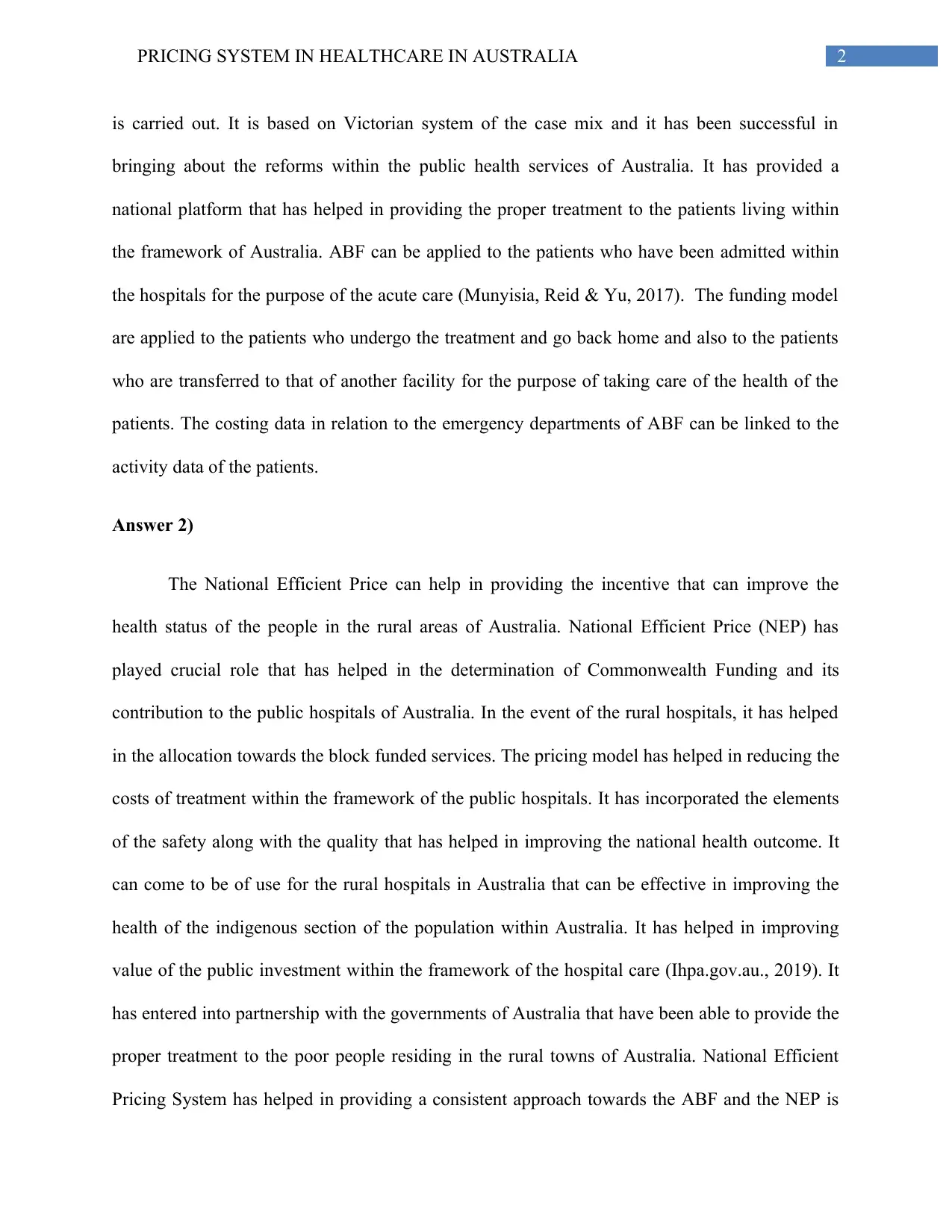
2PRICING SYSTEM IN HEALTHCARE IN AUSTRALIA
is carried out. It is based on Victorian system of the case mix and it has been successful in
bringing about the reforms within the public health services of Australia. It has provided a
national platform that has helped in providing the proper treatment to the patients living within
the framework of Australia. ABF can be applied to the patients who have been admitted within
the hospitals for the purpose of the acute care (Munyisia, Reid & Yu, 2017). The funding model
are applied to the patients who undergo the treatment and go back home and also to the patients
who are transferred to that of another facility for the purpose of taking care of the health of the
patients. The costing data in relation to the emergency departments of ABF can be linked to the
activity data of the patients.
Answer 2)
The National Efficient Price can help in providing the incentive that can improve the
health status of the people in the rural areas of Australia. National Efficient Price (NEP) has
played crucial role that has helped in the determination of Commonwealth Funding and its
contribution to the public hospitals of Australia. In the event of the rural hospitals, it has helped
in the allocation towards the block funded services. The pricing model has helped in reducing the
costs of treatment within the framework of the public hospitals. It has incorporated the elements
of the safety along with the quality that has helped in improving the national health outcome. It
can come to be of use for the rural hospitals in Australia that can be effective in improving the
health of the indigenous section of the population within Australia. It has helped in improving
value of the public investment within the framework of the hospital care (Ihpa.gov.au., 2019). It
has entered into partnership with the governments of Australia that have been able to provide the
proper treatment to the poor people residing in the rural towns of Australia. National Efficient
Pricing System has helped in providing a consistent approach towards the ABF and the NEP is
is carried out. It is based on Victorian system of the case mix and it has been successful in
bringing about the reforms within the public health services of Australia. It has provided a
national platform that has helped in providing the proper treatment to the patients living within
the framework of Australia. ABF can be applied to the patients who have been admitted within
the hospitals for the purpose of the acute care (Munyisia, Reid & Yu, 2017). The funding model
are applied to the patients who undergo the treatment and go back home and also to the patients
who are transferred to that of another facility for the purpose of taking care of the health of the
patients. The costing data in relation to the emergency departments of ABF can be linked to the
activity data of the patients.
Answer 2)
The National Efficient Price can help in providing the incentive that can improve the
health status of the people in the rural areas of Australia. National Efficient Price (NEP) has
played crucial role that has helped in the determination of Commonwealth Funding and its
contribution to the public hospitals of Australia. In the event of the rural hospitals, it has helped
in the allocation towards the block funded services. The pricing model has helped in reducing the
costs of treatment within the framework of the public hospitals. It has incorporated the elements
of the safety along with the quality that has helped in improving the national health outcome. It
can come to be of use for the rural hospitals in Australia that can be effective in improving the
health of the indigenous section of the population within Australia. It has helped in improving
value of the public investment within the framework of the hospital care (Ihpa.gov.au., 2019). It
has entered into partnership with the governments of Australia that have been able to provide the
proper treatment to the poor people residing in the rural towns of Australia. National Efficient
Pricing System has helped in providing a consistent approach towards the ABF and the NEP is
⊘ This is a preview!⊘
Do you want full access?
Subscribe today to unlock all pages.

Trusted by 1+ million students worldwide
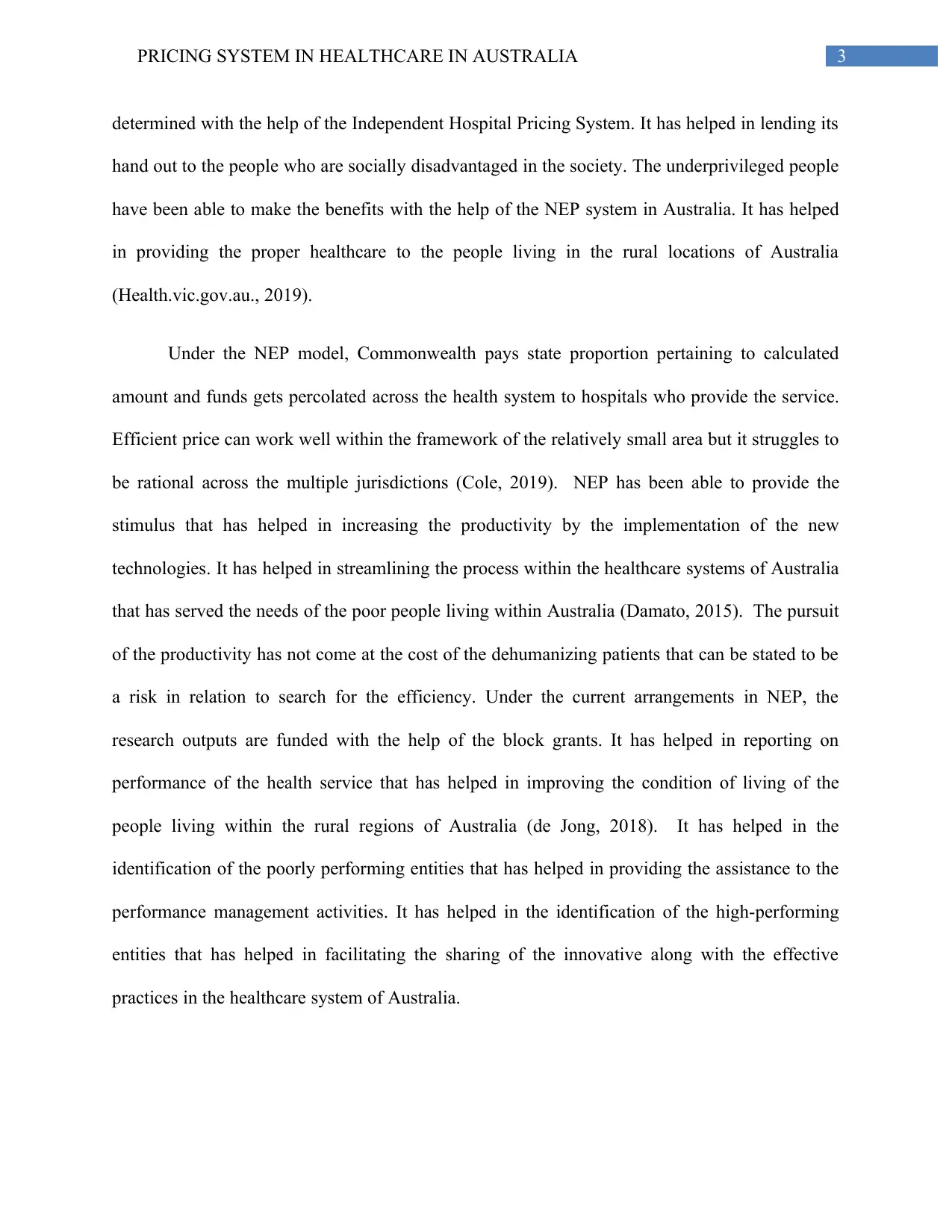
3PRICING SYSTEM IN HEALTHCARE IN AUSTRALIA
determined with the help of the Independent Hospital Pricing System. It has helped in lending its
hand out to the people who are socially disadvantaged in the society. The underprivileged people
have been able to make the benefits with the help of the NEP system in Australia. It has helped
in providing the proper healthcare to the people living in the rural locations of Australia
(Health.vic.gov.au., 2019).
Under the NEP model, Commonwealth pays state proportion pertaining to calculated
amount and funds gets percolated across the health system to hospitals who provide the service.
Efficient price can work well within the framework of the relatively small area but it struggles to
be rational across the multiple jurisdictions (Cole, 2019). NEP has been able to provide the
stimulus that has helped in increasing the productivity by the implementation of the new
technologies. It has helped in streamlining the process within the healthcare systems of Australia
that has served the needs of the poor people living within Australia (Damato, 2015). The pursuit
of the productivity has not come at the cost of the dehumanizing patients that can be stated to be
a risk in relation to search for the efficiency. Under the current arrangements in NEP, the
research outputs are funded with the help of the block grants. It has helped in reporting on
performance of the health service that has helped in improving the condition of living of the
people living within the rural regions of Australia (de Jong, 2018). It has helped in the
identification of the poorly performing entities that has helped in providing the assistance to the
performance management activities. It has helped in the identification of the high-performing
entities that has helped in facilitating the sharing of the innovative along with the effective
practices in the healthcare system of Australia.
determined with the help of the Independent Hospital Pricing System. It has helped in lending its
hand out to the people who are socially disadvantaged in the society. The underprivileged people
have been able to make the benefits with the help of the NEP system in Australia. It has helped
in providing the proper healthcare to the people living in the rural locations of Australia
(Health.vic.gov.au., 2019).
Under the NEP model, Commonwealth pays state proportion pertaining to calculated
amount and funds gets percolated across the health system to hospitals who provide the service.
Efficient price can work well within the framework of the relatively small area but it struggles to
be rational across the multiple jurisdictions (Cole, 2019). NEP has been able to provide the
stimulus that has helped in increasing the productivity by the implementation of the new
technologies. It has helped in streamlining the process within the healthcare systems of Australia
that has served the needs of the poor people living within Australia (Damato, 2015). The pursuit
of the productivity has not come at the cost of the dehumanizing patients that can be stated to be
a risk in relation to search for the efficiency. Under the current arrangements in NEP, the
research outputs are funded with the help of the block grants. It has helped in reporting on
performance of the health service that has helped in improving the condition of living of the
people living within the rural regions of Australia (de Jong, 2018). It has helped in the
identification of the poorly performing entities that has helped in providing the assistance to the
performance management activities. It has helped in the identification of the high-performing
entities that has helped in facilitating the sharing of the innovative along with the effective
practices in the healthcare system of Australia.
Paraphrase This Document
Need a fresh take? Get an instant paraphrase of this document with our AI Paraphraser
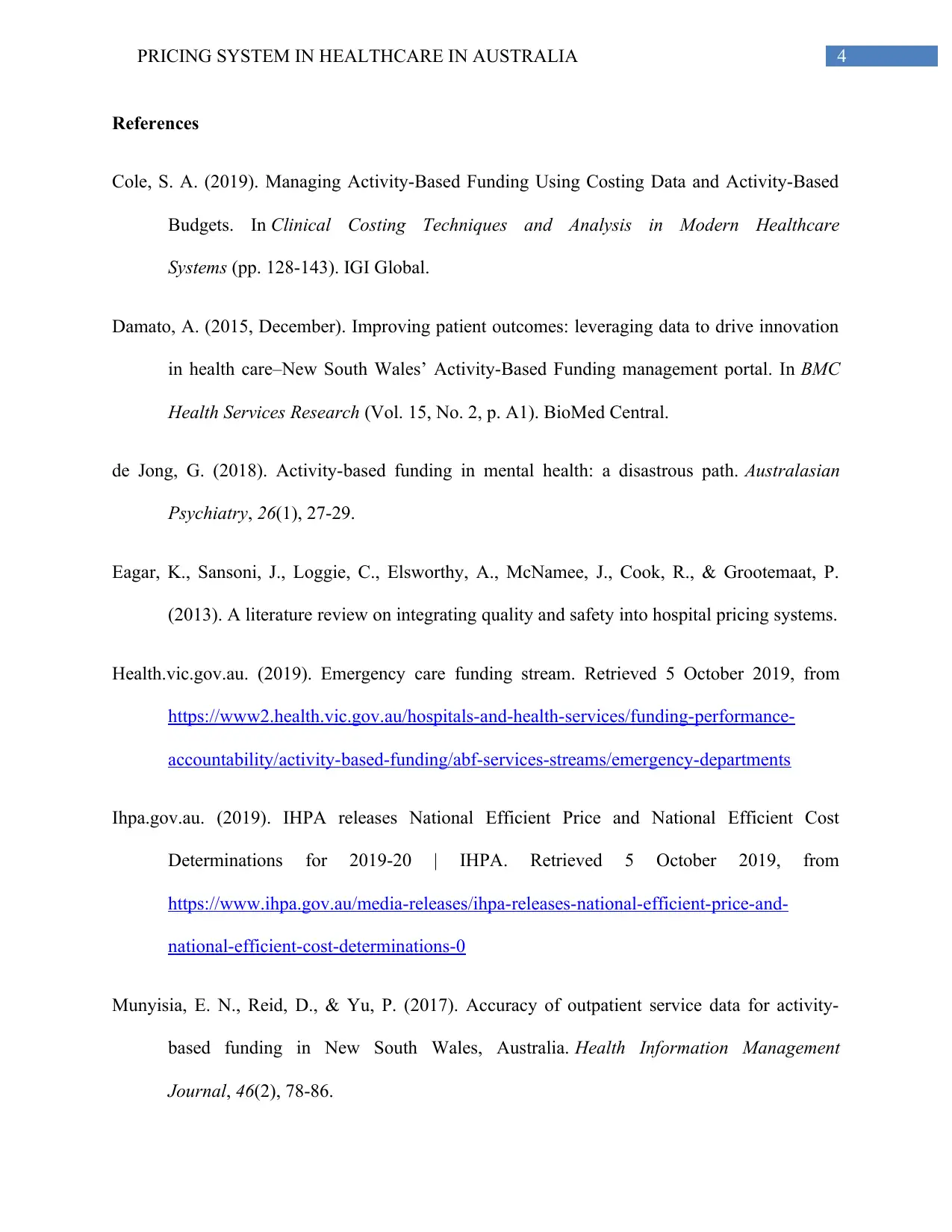
4PRICING SYSTEM IN HEALTHCARE IN AUSTRALIA
References
Cole, S. A. (2019). Managing Activity-Based Funding Using Costing Data and Activity-Based
Budgets. In Clinical Costing Techniques and Analysis in Modern Healthcare
Systems (pp. 128-143). IGI Global.
Damato, A. (2015, December). Improving patient outcomes: leveraging data to drive innovation
in health care–New South Wales’ Activity-Based Funding management portal. In BMC
Health Services Research (Vol. 15, No. 2, p. A1). BioMed Central.
de Jong, G. (2018). Activity-based funding in mental health: a disastrous path. Australasian
Psychiatry, 26(1), 27-29.
Eagar, K., Sansoni, J., Loggie, C., Elsworthy, A., McNamee, J., Cook, R., & Grootemaat, P.
(2013). A literature review on integrating quality and safety into hospital pricing systems.
Health.vic.gov.au. (2019). Emergency care funding stream. Retrieved 5 October 2019, from
https://www2.health.vic.gov.au/hospitals-and-health-services/funding-performance-
accountability/activity-based-funding/abf-services-streams/emergency-departments
Ihpa.gov.au. (2019). IHPA releases National Efficient Price and National Efficient Cost
Determinations for 2019-20 | IHPA. Retrieved 5 October 2019, from
https://www.ihpa.gov.au/media-releases/ihpa-releases-national-efficient-price-and-
national-efficient-cost-determinations-0
Munyisia, E. N., Reid, D., & Yu, P. (2017). Accuracy of outpatient service data for activity-
based funding in New South Wales, Australia. Health Information Management
Journal, 46(2), 78-86.
References
Cole, S. A. (2019). Managing Activity-Based Funding Using Costing Data and Activity-Based
Budgets. In Clinical Costing Techniques and Analysis in Modern Healthcare
Systems (pp. 128-143). IGI Global.
Damato, A. (2015, December). Improving patient outcomes: leveraging data to drive innovation
in health care–New South Wales’ Activity-Based Funding management portal. In BMC
Health Services Research (Vol. 15, No. 2, p. A1). BioMed Central.
de Jong, G. (2018). Activity-based funding in mental health: a disastrous path. Australasian
Psychiatry, 26(1), 27-29.
Eagar, K., Sansoni, J., Loggie, C., Elsworthy, A., McNamee, J., Cook, R., & Grootemaat, P.
(2013). A literature review on integrating quality and safety into hospital pricing systems.
Health.vic.gov.au. (2019). Emergency care funding stream. Retrieved 5 October 2019, from
https://www2.health.vic.gov.au/hospitals-and-health-services/funding-performance-
accountability/activity-based-funding/abf-services-streams/emergency-departments
Ihpa.gov.au. (2019). IHPA releases National Efficient Price and National Efficient Cost
Determinations for 2019-20 | IHPA. Retrieved 5 October 2019, from
https://www.ihpa.gov.au/media-releases/ihpa-releases-national-efficient-price-and-
national-efficient-cost-determinations-0
Munyisia, E. N., Reid, D., & Yu, P. (2017). Accuracy of outpatient service data for activity-
based funding in New South Wales, Australia. Health Information Management
Journal, 46(2), 78-86.
1 out of 5
Related Documents
Your All-in-One AI-Powered Toolkit for Academic Success.
+13062052269
info@desklib.com
Available 24*7 on WhatsApp / Email
![[object Object]](/_next/static/media/star-bottom.7253800d.svg)
Unlock your academic potential
Copyright © 2020–2025 A2Z Services. All Rights Reserved. Developed and managed by ZUCOL.



